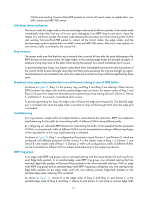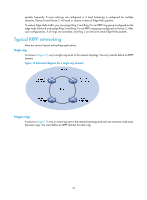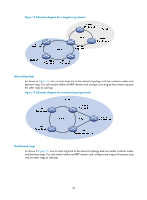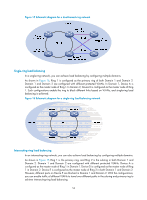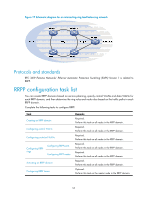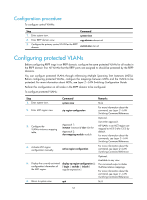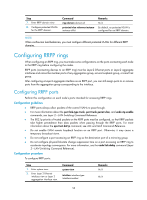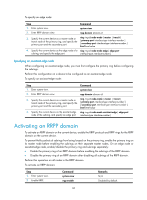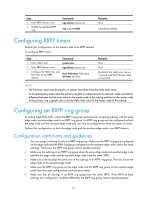HP 6125G HP 6125G & 6125G/XG Blade Switches High Availability Configur - Page 63
Creating an RRPP domain, Configuring control VLANs, Configuration guidelines
 |
View all HP 6125G manuals
Add to My Manuals
Save this manual to your list of manuals |
Page 63 highlights
Task Configuring an RRPP ring group Remarks Optional. Perform this task on the edge node and assistant-edge node in the RRPP domain. NOTE: • RRPP does not have an auto election mechanism, so you must configure each node in the ring network properly for RRPP to monitor and protect the ring network. • Before configuring RRPP, you must construct a ring-shaped Ethernet topology physically. Creating an RRPP domain When creating an RRPP domain, specify a domain ID, which uniquely identifies an RRPP domain. All devices in the same RRPP domain must be configured with the same domain ID. Perform this configuration on devices you want to configure as nodes in the RRPP domain. To create an RRPP domain: Step Command 1. Enter system view. system-view 2. Create an RRPP domain, and enter RRPP domain view. rrpp domain domain-id Configuring control VLANs Before configuring RRPP rings in an RRPP domain, configure the same control VLANs for all nodes in the RRPP domain first. When configuring control VLANs for an RRPP domain, you only need to configure the primary control VLAN. The system automatically configures the secondary control VLAN, and it uses the primary control VLAN ID plus 1 as the secondary control VLAN ID. For the control VLAN configuration to succeed, make sure the IDs of the two control VLANs are consecutive and have not been assigned yet. Perform this configuration on all nodes in the RRPP domain to be configured. Configuration guidelines • To ensure proper forwarding of RRPPDUs, do not configure the default VLAN of a port accessing an RRPP ring as the control VLAN, or enable 802.1Q in 802.1Q (QinQ) or VLAN mapping on the control VLANs. • Before configuring RRPP rings for an RRPP domain, you can delete or modify the control VLANs configured for the RRPP domain. However, after configuring RRPP rings for an RRPP domain, you cannot delete or modify the control VLANs of the domain. You can only use the undo control-vlan command to delete a control VLAN. • To transparently transmit RRPPDUs on a device not configured with RRPP, you must ensure only the two ports connecting the device to the RRPP ring permit the packets of the control VLANs. Otherwise, the packets from other VLANs may go into the control VLANs in transparent transmission mode and strike the RRPP ring. 56



